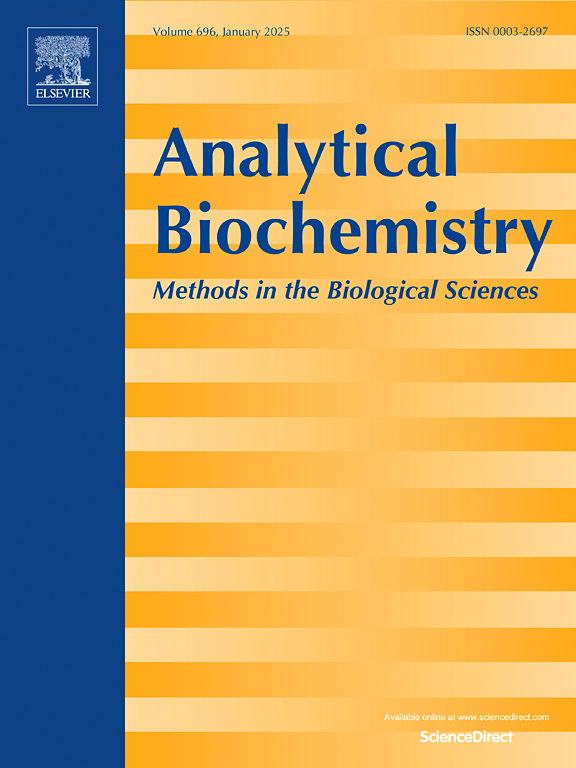Recent focus in non-SELEX-computational approach for de novo aptamer design: A mini review
IF 2.6
4区 生物学
Q2 BIOCHEMICAL RESEARCH METHODS
引用次数: 0
Abstract
Aptamers, single-stranded nucleic acids that bind to specific targets with high affinity and specificity, hold significant promise in various biomedical and biotechnological applications.
The traditional method of aptamer selection, SELEX (Systematic Evolution of Ligands by EXponential Enrichment) takes a lot of work and time. Recent advancements in computational methods have revolutionized aptamer design, offering efficient and effective alternatives. This review examines recent advances in non-SELEX and de novo aptamer design methods, such as Making Aptamers without SELEX (MAWS), AptaLoop, AptaDiff, RNAGEN, RaptGen, Apta-MCTS, UltraSelex, and Torkamanian-Afshar model. These computer methods utilize bioinformatics, machine learning, and molecular modeling to generate high-affinity aptamers, eliminating the need for multiple selection steps in vitro or in vivo. We provide a comprehensive analysis of each method's performance, including binding affinity, specificity, and stability, and discuss their practical applications in diagnostics, therapeutics, and environmental monitoring. Furthermore, we highlight the strengths and limitations of computational methods against the traditional one. The potential challenges, future directions, and emerging.technologies were also presented. This review underscores the transformative impact of computational aptamer design on research and industry, paving the way for rapid and cost-effective development of aptamer-based technologies.

最近的焦点在非选择性计算方法的从头适体设计:一个小回顾。
核酸适体是一种单链核酸,具有高亲和力和特异性,可与特定靶标结合,在各种生物医学和生物技术应用中具有重要的前景。传统的配体选择方法SELEX (Systematic Evolution of Ligands by EXponential Enrichment)需要大量的工作和时间。计算方法的最新进展彻底改变了适体设计,提供了高效和有效的替代方案。本文综述了非SELEX和从头设计适配体方法的最新进展,如制作无SELEX适配体(MAWS)、AptaLoop、AptaDiff、RNAGEN、RaptGen、Apta-MCTS、UltraSelex和Torkamanian-Afshar模型。这些计算机方法利用生物信息学、机器学习和分子建模来生成高亲和力的适体,从而消除了在体外或体内进行多重选择的需要。我们全面分析了每种方法的性能,包括结合亲和力、特异性和稳定性,并讨论了它们在诊断、治疗和环境监测方面的实际应用。此外,我们强调了计算方法相对于传统方法的优势和局限性。提出了潜在的挑战、未来的发展方向和新兴的技术。这篇综述强调了计算适体设计对研究和工业的变革性影响,为基于适体的技术的快速和经济发展铺平了道路。
本文章由计算机程序翻译,如有差异,请以英文原文为准。
求助全文
约1分钟内获得全文
求助全文
来源期刊

Analytical biochemistry
生物-分析化学
CiteScore
5.70
自引率
0.00%
发文量
283
审稿时长
44 days
期刊介绍:
The journal''s title Analytical Biochemistry: Methods in the Biological Sciences declares its broad scope: methods for the basic biological sciences that include biochemistry, molecular genetics, cell biology, proteomics, immunology, bioinformatics and wherever the frontiers of research take the field.
The emphasis is on methods from the strictly analytical to the more preparative that would include novel approaches to protein purification as well as improvements in cell and organ culture. The actual techniques are equally inclusive ranging from aptamers to zymology.
The journal has been particularly active in:
-Analytical techniques for biological molecules-
Aptamer selection and utilization-
Biosensors-
Chromatography-
Cloning, sequencing and mutagenesis-
Electrochemical methods-
Electrophoresis-
Enzyme characterization methods-
Immunological approaches-
Mass spectrometry of proteins and nucleic acids-
Metabolomics-
Nano level techniques-
Optical spectroscopy in all its forms.
The journal is reluctant to include most drug and strictly clinical studies as there are more suitable publication platforms for these types of papers.
 求助内容:
求助内容: 应助结果提醒方式:
应助结果提醒方式:


